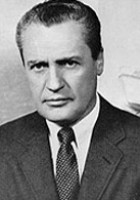Former General Counsel
NCTA
There had been a ’freeze’ on the licensing of television stations for several years while the FCC was developing a city-by-city channel allocation plan so that channels could be assigned and licensed to operate with minimum interference to each other. At the time, there probably was no more than a hundred stations in the entire United States, and no UHF. By itself, the Astoria situation was just an interesting and unique solution for a small group of people 150 miles from the nearest station.
E. Stratford “Strat” Smith played a pivotal role in outlining cable’s legal framework and, as the National Cable Television Association’s first general counsel, helped lead the way in getting them written into law.
In 1949 Smith served as a staff attorney for the FCC’s Common Carrier Division. When the agency began getting reports of community antenna systems popping up to deliver clearer TV to rural communities and small towns in Pennsylvania, Oregon, Arkansas and West Virginia, Smith found himself assigned to investigate. He tracked down the operators of some of the systems and decided to go visit one, picking Martin F. Malarkey’s Pottsville, Pa. system because it was closest.
Most experts at the time expected community antennas to wither away over time as UHF television, and then in its infancy, took hold. Smith’s visit to Pottsville convinced him otherwise, and by 1952, he’d left the FCC to open a private practice in Washington.
In 1952, Smith’s first order of business was to frame a legal definition that would allow community antenna systems to operate without being throttled by larger industries.
Smith argued that community antennas relayed “signals” not “programming” to subscribers who couldn’t receive them over the air. Once a broadcast signal went out over the airwaves, it was free to anyone, he maintained, so CATV systems didn’t need a TV station’s permission to carry its signal and weren’t subject to copyright fees.
By the end of the 1950s, there were 640 CATV systems with more than 650,000 subscribers. Cable was no longer a fledgling, rural phenomenon but a growing industry that looked toward urban expansion. Large metropolitan broadcasters and movie studios saw that as a direct threat to their revenue streams. They unleashed political and legal action that would bring Smith to the most humiliating low, and exhilarating high, of his career.
As the 1960s unfolded, a more activist FCC began regulating cable more strictly than Pastore’s legislation would have dictated.
By then, Smith’s master antenna concept, which had protected the industry from regulation for years, came under increased assault, both from within the industry and outside it. He fought to keep the master antenna concept alive CATV systems were ruled not liable to pay copyright fees.
Smith has remained a popular figure in the cable industry even past his retirement in 1972. For years after he left the NCTA, he was in frequent demand at state and regional association meetings. In 1988, he accepted an invitation to help develop the National Cable TV Center and Museum at Penn State University. Later, he was named to Penn State’s Cable TV Pioneer Chair in Cable Telecommunications, a position endowed by the Cable Center.
Future historians may well write Smith’s legacy this way: First he saved cable and then he helped preserve its history.

